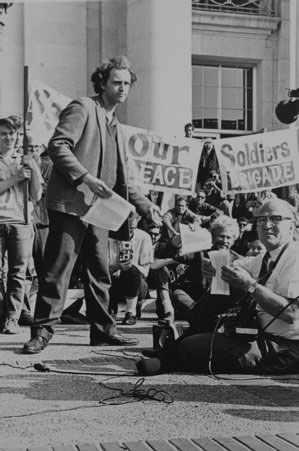Mario Savio: Student revolutionary turned Urban math teacher

Mario Savio hands out flyers at a protest.
December 2, 1964. Mario Savio, a young man the newspapers describe as “slender, 6-foot-1, sloping at the shoulders, clad usually in baggy slacks and a heavy jacket,” stands in front of a throng of UC Berkeley students, delivering what would become one of the most famous speeches of the sixties. He speaks fluidly — all traces of the stutter that had plagued him since childhood gone — of the grinding machine of oppression and how to stop it. A few minutes later, he is seized by the police and dragged away. At the time, the man is 21 years old.
Flash forward two decades and Savio is speaking again, a little more softly perhaps, of tangents, circles and protractors. He no longer stands on the steps of Berkeley’s Sproul Hall, but in a room full of big-haired, baggy-pants-wearing teenagers at a small private high school with a hippie reputation called Urban.
“He was really warm, gentle, friendly,” recalled Urban math teacher Richard Lautze of Mario Savio. Lautze remembers little about Savio and claims he did not know the other teacher at all outside of Urban’s walls. But when asked if he ever saw flashes in Savio of the firebrand youth who was arrested multiple times for his radical politics, Lautze said, with great certainty, “Never.”
The FBI and Lautze shared that opinion. The bureau stopped their investigations of Savio in 1975, several years before he began teaching at Urban. FBI files on Savio, which were released through the Freedom of Information Act, describe everything from his address, to his typical manner of dress, to the clubs he joined in high school (newspaper, peer tutor, model UN, chess club — to name a few). However, the FBI paid particular attention to Savio’s suspected communist and socialist behaviors. Though in December of 1968, reports claimed that “there was still no evidence that Savio was under the influence of any subversive group,” the FBI was not to be shaken from Savio’s trail. And it was not only the bureau that was interested. Savio caught the attention of his fellow Berkeley students and the world on October 1, 1964 when he — after politely removing his shoes — mounted a police car in the center of Sproul Plaza. The car contained a Berkeley graduate named Jack Weinberg, who had been arrested moments prior for distributing pamphlets on racial equality. On top of the car, surrounded by the hundreds of students who had sat down in front of the vehicle to block its way out of campus, Savio eloquently deplored so-called “free speech” at Berkeley. When someone asked who he was, he introduced himself, and the Berkeley free speech movement found its leader.
Though Savio’s police-car-as-a-podium speech may have produced the most striking image of his student radical career, the speech he made two months later on the steps of Sproul hall is by far his most famous. If you are an Urban sophomore or upperclassman, you have likely seen the grainy footage of Savio’s “Bodies on the Gears” speech in your Remaking America or Recent America class. “There’s a time,” said 21-year-old Savio, “when the operation of the machine becomes so odious, makes you so sick at heart that you can’t take part … and you’ve got to put your bodies on the gears, and upon the wheels, and upon the levers … and you’ve got to make it stop!”
Urban English and History teacher Dan Murphy remembers reading these words for the first time. Murphy, then 23 and a graduate student at Yale, went to the newspaper office every Sunday to wait for a copy of The San Francisco Chronicle. “I wanted to see the football scores,” says Murphy. In thumbing through the paper he came across the transcript of Savio’s speech. Murphy, who graduated Berkeley a year before Savio arrived, remembers that suddenly everyone was saying, “There’s this guy Mario Savio and he just gave an amazing speech.” Murphy could see what the fuss was about. “The speech,” he said, “was electrifying.”
Murphy echoes Lautze in saying that Savio’s presence at Urban was quiet. “We did not go parading him in front of everybody at all-school meetings,” Murphy said. It does not seem, however, that Savio never spoke on social activism in front of the school. Henri Picciotto, former head of Urban’s math department, remembered Savio talking to the student body about the Civil War in El Salvador. “He had a bit of a stutter when talking one on one,” recalled Picciotto, “but became totally eloquent when speaking at the all-school meeting.”
Savio’s teaching career at Urban was short, but not for any malevolent reason. “He was only hired for one or two courses,” wrote Picciotto in an email. “So he didn’t really leave. He did the job he was hired for and then went on with the rest of his life. I think he really enjoyed his time at Urban.”
On November 6, 1996, Savio died of a heart fibrillation. He was only 53. LeRoy Votto, current Urban history teacher, recalled, “He was a person of passion, but dignity … He didn’t fall in love with the microphone. It wasn’t his purpose.”











